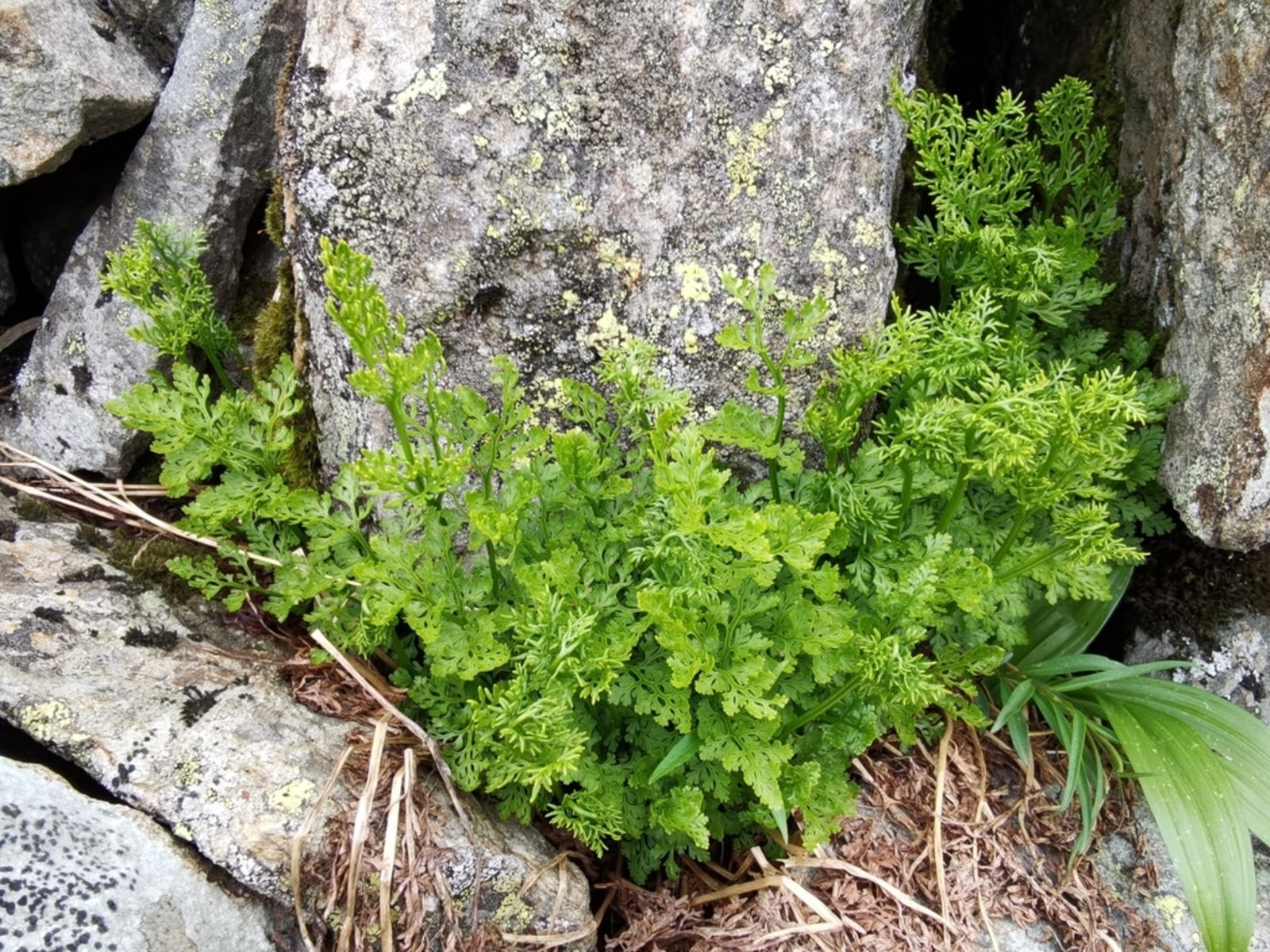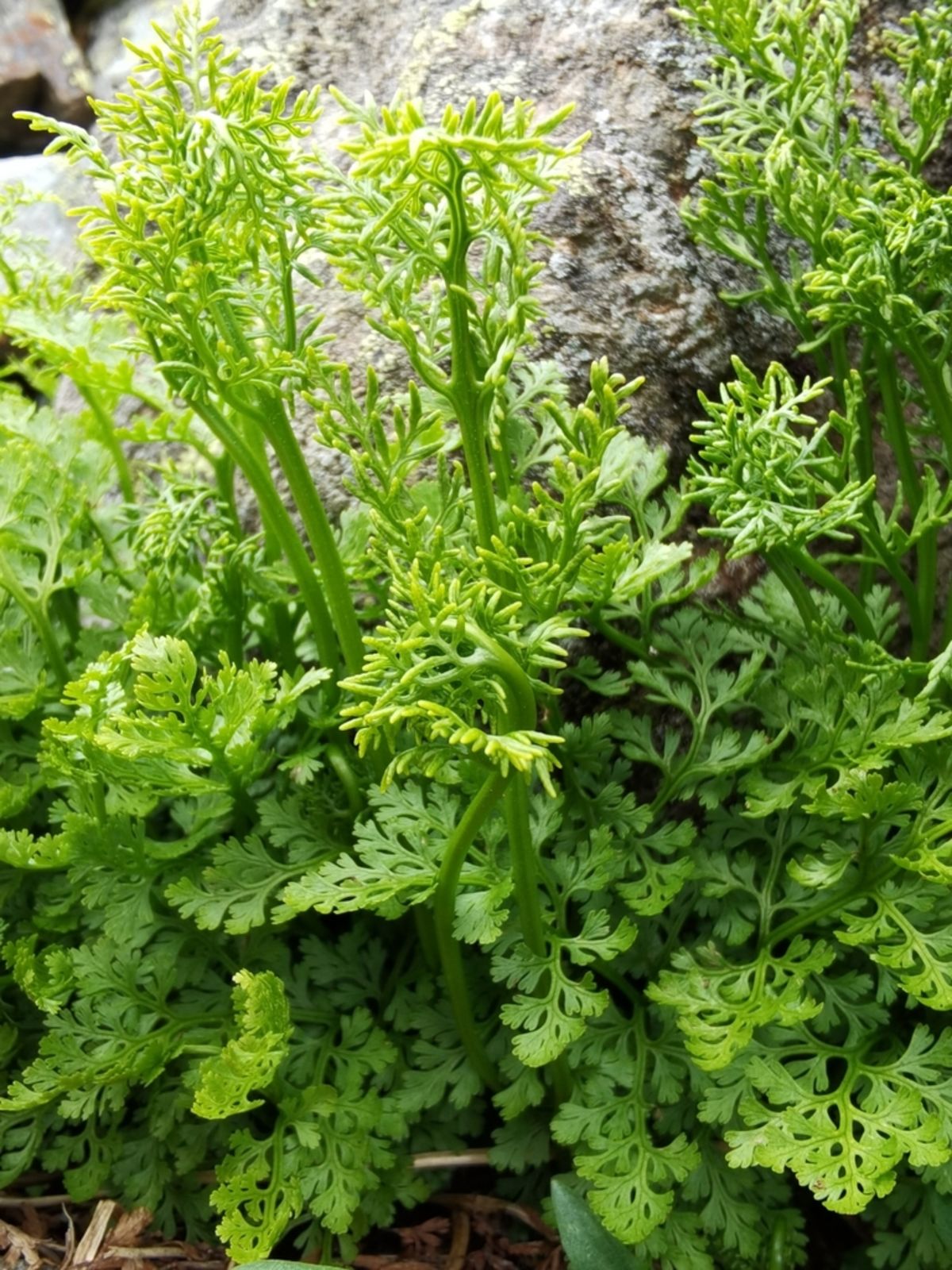Wavy Rockbrake
cryptogramma crispa
Also known as: ["Wavy Parsley Fern","Rock Brake"]
Overview
A hardy, evergreen fern with wavy, parsley-like fronds, native to rocky, alpine environments.
Benefits & Perks
["cold hardy","shade tolerant","wildlife attractant (bees, butterflies, birds)"]
Botanical Classification
| Phylum: | Tracheophyta |
| Class: | Polypodiopsida |
| Order: | Pteridales |
| Family: | Pteridaceae |
| Genus: | Cryptogramma |
| Botanical Name: | Cryptogramma crispa |
Plant Characteristics
Basic Information
- Category: Leaf Plants
- Suitable Location: rock gardens, alpine troughs, or shaded slopes
- Suitable For:
- Is Weed: No
- Allergenicity: low
Environmental Needs
- Climate: {"temperatureRange":"−20–30°C"}
- Hardiness: {"zones":"3–7"}
- Misting: rarely required, only if ambient humidity is very low
- Drainage: Fast-draining to prevent waterlogging.
- Soil Type: Well-draining, alkaline soil with added organic matter like leaf mold or compost.
Maintenance Level
- Maintenance Level: low
- Toughness Level: high
- Pruning Frequency: As needed, typically in late winter or early spring before new growth emerges.
- Pruning Intensity: Light pruning only.
Care Details
Ideal Sunlight Coverage:
Bright indirect light for 4–6 hours daily. Tolerates partial shade, especially in hot climates.
Sunlight Tolerance Tips:
Acclimate gradually to direct sun to prevent scorching. Place in dappled light outdoors or near an east-facing window indoors.
Care Requirements
Care Difficulty
moderatemoderate
Sunlight
partial shade to full sun
Avoid harsh afternoon sun; rotate plant for even growth; provide shade during peak summer.
Watering
every 7–10 days during active growth, reduce in winter
Water deeply but infrequently; ensure good drainage; avoid waterlogging.
Soil
well-draining, rocky, or sandy loam with low fertility
pH: Alkaline to neutral (pH 7.0–7.5).
Ensure soil dries between waterings; avoid heavy clay mixes; test pH periodically.
Temperature
Prefers cool temperatures, ideally 50–65°F (10–18°C). Tolerates cold but not extreme heat.
Protect from frost; avoid sudden temperature swings; maintain consistent cool conditions.
Fertilizing
every 4–6 weeks during growing season, none in winter
Fertilize only when actively growing; flush soil occasionally to prevent salt buildup; use a balanced formula.
Propagation
Methods
By division or spores. Division is more reliable for home growers.
Step-by-Step Propagation Guide
- Divide clumps into smaller sections with roots.
- Plant spores on sterile medium.
- Keep consistently moist.
Best Time: Early spring before active growth begins.
Environment
High humidity (70–90%), indirect light, and cool temperatures (50–60°F) for spores; normal conditions for divisions.
Medium
Well-draining soil mix with added perlite or sand for spores; moist peat for divisions.
Hormone
Not required for divisions; optional for spores to encourage germination.
Timeline
Divisions establish in 1–2 months; spores may take several months to germinate and years to mature.
Tools Needed
Sharp knife, sterile potting mix, humidity dome, watering can.
Quick Tips
Use clean tools to prevent disease; keep divisions shaded initially; be patient with spore germination.
Pruning & Repotting
Pruning Guide
Method
Snip individual fronds at the base with clean, sharp scissors or pruners.
Pruning Plan
Minimal pruning needed. Focus on removing dead or damaged fronds to maintain appearance and health.
Tools
Pruning shears, scissors, disinfectant.
Checklist
Sanitize tools; remove only dead/damaged fronds; avoid cutting new growth.
Repotting Guide
Best Season
Early spring before new growth starts.
Pot Size
One size up from current pot, ensuring good drainage.
Method
Gently remove plant, trim roots if necessary, place in a slightly larger pot with fresh soil, and water lightly.
Suggestions
Repot only when overcrowded or soil is depleted, typically every 2–3 years.
Checklist
Check root bound status; use fresh soil mix; ensure drainage holes; water sparingly post-repotting.
Advanced Care Tips
Watering Mastery
Watering Checklist
Check soil moisture; water deeply; ensure drainage; adjust for season.
How to Apply Water Properly
Water at the base of the plant, ensuring moisture reaches the root zone without wetting foliage. Allow excess water to drain away completely.
Watering Schedule Tips
Water moderately, allowing soil to dry slightly between waterings. Reduce frequency in winter to prevent root rot.
Soil Improvement
Add perlite or coarse sand for drainage; incorporate compost for fertility; adjust pH with lime if needed.
Temperature Stress Management
Signs of Temperature Issues
Wilting, yellowing leaves, or stunted growth in excessive heat; browning leaf edges in cold stress.
Cold Stress
Slows growth and may cause leaf discoloration or dieback in prolonged cold without protection.
Solution: Provide a sheltered location; use frost cloth in freezing conditions; ensure good air circulation.
Hot Stress
Leaves may scorch, wilt, or drop in high temperatures, especially with low humidity.
Solution: Move to a cooler spot; increase humidity with misting; provide shade during peak heat.
Fertilizing Guide
Fertilizing Checklist
Check growth phase; dilute fertilizer; apply to moist soil; avoid contact with foliage.
Fertilizing Method
Use a balanced liquid fertilizer diluted to half strength every 4–6 weeks during active growth (spring/summer). Avoid fertilizing in winter.
Common Problems & Solutions
Toxicity Warning
Cats
Non-toxicCryptogramma crispa is not considered toxic to cats. The plant lacks compounds known to be harmful to felines.
⚠️ Symptoms:
🌿 Toxic Parts:
⚡ Toxic If:
if eaten
Dogs
Non-toxicCryptogramma crispa is not considered toxic to dogs. The plant does not contain known toxic compounds that would cause significant harm to canines.
⚠️ Symptoms:
🌿 Toxic Parts:
⚡ Toxic If:
if eaten
Humans
Non-toxicCryptogramma crispa, commonly known as parsley fern, is generally considered non-toxic to humans. However, like many ferns, it may cause mild gastrointestinal discomfort if consumed in large quantities due to its high fiber content and potential for indigestible compounds.
⚠️ Symptoms:
🌿 Toxic Parts:
⚡ Toxic If:
if eaten in large quantities
Frequently Asked Questions
Q: Is Cryptogramma crispa toxic to pets?
A: No, it is non-toxic to dogs and cats.
Q: Where does Wavy Rockbrake grow best?
A: It thrives in rocky, alpine environments with partial shade and well-drained soil.
Q: How often should I water this fern?
A: Water sparingly, allowing the soil to dry slightly between waterings; overwatering can cause root rot.
Quick Reference
| Family: | Pteridaceae |
| Care: | moderate |
| Light: | partial shade to full sun |
| Water: | every 7–10 days during activ |
Get Expert Care Tips
Download the Plantious app for personalized care reminders and plant identification!
Google Play App Store








